John Cox
John Cox had the unenviable task of taking over as first grade captain from Col Johnston when the latter stepped down at the end of the 1964-65 season.
John came to the Club in 1963-64 with quite a considerable background of experience. He had started his cricket career in the Upper Hunter. In 1947 at the age of 16 he had the distinction of being the first boy chosen from that area to attend the Country Boys Coaching Class. He played in a Muswellbrook Colts’ team that was organised by Jim White and in 1950 was selected in the very first Emu Colts’ team – a team that was actually captained by Jim White.
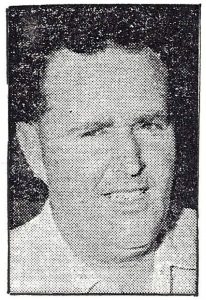
In 1949-50 he represented Hunter Valley at the Country Week Carnival in Sydney.
Seeking to develop his cricket, he began traveling to Newcastle from Muswellbrook each weekend to play for Merewether in the city first grade competition. He hit the headlines on one occasion when he collapsed after bowling 25 successive overs for Merewether against Wallsend in heatwave conditions. At the age of 22, he moved to Newcastle after being signed up to play Rugby League for South Newcastle.
He appeared at an early age in a number of representative matches. In 1952- 53 he played for a Newcastle representative side against Jack Cheetham’s touring South Africans. He top-scored with 65 when Newcastle played Jack Chegwyn’s X1 in a “welcome home” match for Jim de Courcy after the 1953 Australian tour of England. He also played in a Newcastle Testimonial match for Stan McCabe and Bill O’Reilly (two Australian Test cricketers of the 1930s) and during the match faced English bowler Alec Bedser and New Zealand Test star, Martin Donnelly.
After playing for Western Lakes Club in the Newcastle first grade competition for six seasons, he moved to Lorn and started playing with Northern Districts.
In his first season (1963-64) he soon showed his all-round ability and helped to offset the loss of the Elliott twins to Combined City. He finished the season with 437 runs, including 139 against Weston-Kurri and a fine match-winning 89 in the final. With his spinners, he took 22 wickets, and in the slips he showed his sharp reflexes by snapping up 16 catches.
The next season was to be another memorable one for John in that he scored Maitland’s first post-war double century. In a match against Western Suburbs at Police Boys wicket, he hit up 201 to dominate the afternoon’s play. The Mercury described his innings as follows: “Cox in a chanceless innings revealed every stroke in the game and was on top throughout his stay at the wicket, scoring at a rate of better than 50 runs an hour. He hit 33 fours and one five and featured with Col Johnston in a third wicket partnership of 127”. He ended up scoring 503 runs for the season and took 27 wickets.
In 1965-66 he took over as captain from Col Johnston. His team report for that season started out: “To our many club supporters I know it will seem strange for a First Grade Report by a captain other than Colin Johnston, Col first being elected captain of Norths in 1938 and holding the position with distinction until last season.”
The season was not an easy one for John – the Club was “in an unhappy state of mind” after suffering the disappointing loss of two of its most promising juniors to Police Boys, Glenn Brooker, and Rob Robilliard.To make matters worse the team got away to a disastrous start in the early matches. However, the side under John’s captaincy came back strongly to end Easts’ winning run and to make the final. John himself maintained good form to score 307 runs and take 14 wickets.
John had the satisfaction in the following season of captaining the team when it won the double – the premiership and the final. ln his team report, he referred to the wonderful team spirit and the fact that “the boat was rowed together”. A note attached by the Secretary to the bottom of the captain’s report gave credit to John’s own contribution to the team’s success: “No crew, however, well they row together, can do much without a capable cox. And there is none better than our particular ‘cox’ to get the most out of each individual member of his ‘crew’, as individuals and as team members, on and off the field. As for his own performances, modestly overlooked, it should be said that, although he had no big score, he was the model of consistency especially in the first half of the season, and has never batted better since being with Norths … Shoulder trouble prevented him from diddling many with his straight-breaks, but there was no decline about his fielding. He brought off some splendid catches, and despite no visible signs of a decrease in bulk, he was as agile as ever.”
Speaking of the “decrease in bulk”, John himself said with good humour that for years he dieted in a bid to lose weight, but he still remained a solid fourteen stone.
He played with Cessnock Workers Club in 1967-68 but returned the following season and in a premiership-winning team, captained by David Rutherford, finished at the top of the Club’s batting aggregate and average with 466 runs at 42.3. He figured in a Club record third wicket partnership of 181 with Glenn Brooker against Easts at East Maitland. He was dismissed for 97 – the second time that he had been dismissed for 97 during the season. His innings included 18 fours.
While with Norths John represented the Maitland Association in John Bull Shield matches. In 1963 he played in the Hunter Valley team against Benaud’s Sheffield Shield team at the Maitland Sportsground and in 1966 he captained the Maitland team in a Chegwyn match at Lorn Park.
1968-69 was to be John’s last season with the Club. After moving from Lorn to Bellbird, he played a couple of seasons with Cessnock Workers and Weston Kurri before retiring.
His attitude to the game was well-summed up in a newspaper article in 1964: “Genial, round-faced John Cox, of Lorn, is a rare type of cricketer who exudes modesty and keeps no record – mental or written – of his runs and wickets. ‘I play for the love of the game; not to beat any appearance record or runs aggregate, ‘he says in his quiet voice.”
Roger Moylan Senior
Roger Moylan Snr. was associated with Northern Districts Club for more than twenty years. He is a fine example of a Club player who may not have reached any great heights in cricket but who always gave his best to the Club.
Apart from half a season in first grade in 1957-58 and a few “fill-in” games, he spent all of his cricket career from 1949-70 in second grade. For a number of years from 1956, he also captained the team.
Roger started out mainly as a bowler. In what appears to have been his first season (1949-50) in second grade he took 14 wickets and scored 80 runs from 13 innings.
In 1951-52 he took 66 wickets but his batting had not shown much improvement – scoring only 65 runs from 15 innings.
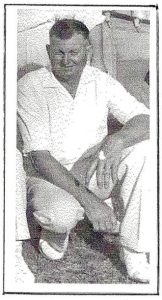
The following season’s second grade Report noted: “Of the bowlers that stalwart club man, Roger Moylan, did by far the bulk of the work and took most wickets (45). On one occasion he performed the extremely rare feat of securing all ten wickets.”
When Roger took over the second grade captaincy in 1955-56 there was a marked turn-around in his batting. The report read: “One does not expect Roger to be at the top of the batting aggregate but he was and held the team together with his batting on more than one occasion. He topped the aggregate with 130 runs at an average of 18.5. Roger claims the success of his runs is due to the practice he received at the nets during the season.”
From then on Roger moved into the category of an all-rounder and in 1957-58 was even promoted into first grade for the first half of the season. Although he only had limited opportunities in first grade, he made his presence felt – “Batting late on the list in two fairly low scoring innings, he scored 25 and 28, both not out, respectively against Wests and Weston-Kurri, scores which enabled us to win both games.”
The following season he was back in second grade where he continued to play up until 1970. During that time he was a consistent performer with bat and ball.
In 1959-60 he headed the second grade division 2 bowling aggregate with 69 wickets at an average of 6.5.
The 1960-61 Report recorded: “The season of 1960-61 could be called Roger Moylan’s year at least as far as the second grade is concerned. He not only headed the batting aggregate and average with 270 runs at 22.5 but also took the bowling honours with 55 wickets at 8.6. Here is an example of practice, for I know Roger is one of our most consistent visitors to the nets during the week.”
In 1963-64 it was reported that “Roger Moylan again showed his ability by scoring an unconquered 103 against the top team of East Maitland … He finished with 258 runs at 19.8 and bowled to the tune of 21 wickets at 13.5”.
When he again took over the second grade captaincy in 1965-66 from Basil Johnston, he topped the 500 mark and headed the District aggregate by scoring 525 runs at an average of 37.5. Included in that tally was an innings of 172 against GUOOF when he created a district record partnership of 184 runs for the third wicket with young David Rawling.
On two occasions he headed the District second grade bowling averages – in 1964-65 with 24 wickets at 7.7 and in 1968-69 with 39 wickets at 7.5.
Roger was actively involved in the administration of cricket. He was a Club Committee member and Selector for many seasons and also helped with the Clubs Under 15 team. He also served as a member of the Association’s Board of Control from 1968-70.
His untimely death in 1970 came as a blow to the Club. 1970-71 included the following tribute: “lt is with very deep regret that we record the passing of one of our most loyal and conscientious members in Roger Moylan. For 25 years Roger was a keen player with our team as well as serving the Club well on all our committees. More of his type would certainly be a great asset to the Club and its administration.”
Glen Brooker
Glenn Brooker was a talented opening batsman for Northern Districts during the sixties.
He showed considerable promise when he started playing third grade with the Club in 1961-62. In his first season, he scored 351 runs and as an opening bowler took 64 wickets.
The following season he was promoted to second grade.
The Captain’s Report noted: “Of the players, possibly the most outstanding was schoolboy Glenn Brooker who was promoted from the 3rds after playing 5 innings in that grade.
This young allrounder was selected to open the innings with Barry Smith after only two games in the higher grade. He topped the batting with 250 runs at an average of 27.7 and took 15 wickets.”
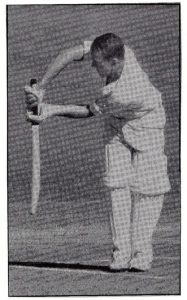
1963-64 saw Glenn playing his – first season in first grade at the age of 15. He opened throughout and totaled 368 at 24.5. This was described as “a remarkable performance, the manner in which he scored his runs being particularly pleasing. Blessed with some magnificent shots, a keen eye, and a desire to hit the ball, it now only requires him to gain more concentration and a little more patience when the bowling is on top for high realms of the game to be open to him.”
In 1964-65 he figured in a district record second wicket partnership of 256 with Allan Elliott in a match against Raymond Terrace at Lorn Park. This broke the previous record of 209 that had been set by Colin and Alan Johnston for Northern against Weston Kurri in 1957.
The Mercury gave the following account of Glenn’s innings: “Brooker batted with great freedom and power to get his 152 in 135 minutes, with 20 fours and 3 sixes. He clouted 25 runs in one over from Lindsay”. The record partnership helped Northern amass 5 for 406 – the first postwar 400 innings in a first grade match!
In 1965-66 Glenn transferred to Police Boys Club but after a troubled season returned to Northern the following season where he just failed to reach 500 runs – scoring 487 at 40.5 and taking 9 wickets with his spinners.
In 1967-68 he batted at number three or four but was less successful and only scored 258 runs. After reverting the next season to the opening position, he showed a return to form totaling 439 runs with consistent scores of the ’30s and ’40s. In one match against Easts, the competition leaders, he scored a brilliant 94 and shared in a Club record third wicket partnership of 180 with John Cox. His spin bowling was also proving to be an asset and during the season he took 20 wickets.
He had another very successful season in 1969-70 scoring 409 runs and posting a century in the minor final against Raymond Terrace.
By 1970-71 he was beginning to look further afield. He started the season with Belmont in the Newcastle competition but returned to play with Northern in January. Soon after he hit up a century against Police Boys at Lorn Park and still tallied 261 runs from 10 innings at an average of 43.5 to top the Club’s batting average.
That was to be his last season with the Club before moving on to play in the Newcastle competition. While with Northern, Glenn had an impressive representative record. In 1964-65 he was selected for the Country Boys Coaching Class, and in 1966-67 toured NZ with the Emu Colts team. After playing John Bull Shield with Maitland from the age of 15, he was a regular representative for a number of seasons in Hunter Valley teams in the Country Trial matches and in 1967-68 was chosen in the Combined Country Seconds.
Jeff Crittenden
Jeff Crittenden had a long association with the Club. Starting out as a wicket-keeper batsman, he later showed his versatility by developing into a successful spin bowler.
After playing with Police Boys junior teams, Jeff had his introduction to Northern Districts first grade in 1963-64. He played the season in second grade but was called up to play in the first grade final against Combined City. The first grade Report noted: “At the tender age of 14 Jeff Crittenden had the unnerving experience of making his first grade debut as the ‘keeper in the final! He did splendidly and with his distinct batting ability. Is another who could go on to higher spheres.”
ln second grade he had shown his batting ability by scoring 280 runs.
The following season he had a regular place behind the stumps in the first grade team and continued to show a lot of promise.
“Jeff Crittenden, our diminutive 15-year-old keeper, fitted into the team most pleasingly. Of course, he lacks experience but 21 catches and 10 stumpings underline his great promise. With the season half-over, he had only scored 33 runs but, with more opportunity later, he finished with a very creditable 225 and several of his innings underlined his splendid potential.”
In 1965-66 his batting really flourished and he finished the season top of the Club’s batting aggregate and average and second in the District aggregate with 544 runs at 34.0.
The following season he scored his first century in first grade with an innings of 112 against Raymond Terrace at Lorn. His opener’s innings of 53 in the final against Easts was also described by his captain, John Cox, as “a gem”. However, there was some criticism of his keeping during the season with his captain’s comment that “not only for his own sake but for the sake of Norths, I wish he would take his keeping more seriously”.
Jeff played two more seasons with the Club with moderate success before moving to Sydney where he played in the first grade competition with Randwick and then North Sydney.
In this first phase of his cricket career in Maitland Jeff played in the Colts and John Bull Shield competitions. ln 1967-68 he topped the John Bull Shield batting aggregate with 408 runs including 126 not out against Upper Hunter and 98 against Gosford-Wyong. The Association Report described “his form, both in keeping and batting, particularly in the first half of the season” as “brilliant”.
In 1966-67 he was chosen for the Country Boys Coaching Class and in 1968-69 was captain of the Emu Colts team that toured NZ. At the end of the tour, he was highly commended for his leadership skills both on and off the field.
After his sojourn in Sydney Jeff returned to Maitland in 1976-77 and took over as captain of Northern’s first grade team. He led the team to a minor premiership success and scored 317 runs including 79 against Morpeth in the semi-final. At this stage with Will Callinan behind the stumps, Jeff gave away the wicket-keeping gloves and began to “rollover his arm”, taking 9 wickets for the season.
Apart from a season with Bolwarra in 1986-87 Jeff continued to play first grade with the Club up until 1990 and captained the team for four more seasons. It was during this period that he was very successful with his spin bowling – so successful that in 1979-80 he headed the District bowling averages with 48 wickets at 10.1. In one match against Police Boys at Lorn Park, he took 7-26 off 12 overs. His captain for the season, Peter Rawling, commented: “Special congratulations to ‘fat man’ on securing 54 wickets for the season … No batsman got on top of him and his line and length during the season never faltered. Jeff bowled nearly 300 overs during the season and it would be fair to say he would not have bowled anywhere near that figure had he been in charge of the team. “He followed up this success In the next two seasons by taking 43 and 42 wickets respectively.
On his return to Maitland, Jeff continued to play representative cricket and to captain the John Bull Shield team up until 1982. When he stepped down after taking over as licensee of the Grand Central Tavern.
During his time with the Club, Jeff was actively involved, particularly with the organisation of social and fund-raising activities. At various stages, he served as Assistant Secretary, Selector, and Club Coach. As a member of the Social Committee, he deserves a lot of credit for fostering a social atmosphere among Club members after the Saturday matches were over. Among one of his more adventurous fund-raising enterprises was a “games night extravaganza” held at a barn in lorn. With Don Nichols, he was also mainly responsible for organising a number of Ellimatta Cup Ten Over Competition Days with proceeds going to the support of the local chi Idren’s Home.
Jeff was a member of the Association’s Board of Control from 1981-82 and Representative Secretary from 1980-81. For a number of seasons, he also gave the benefit of his wide background of experience by serving as a Selector for the Association and Hunter Valley Cricket Council.
Warren Trappel
Warren Trappel came to the Club in 1963-64 at the age of 18 after having played for West Lakes in the Newcastle competition. He was persuaded to play for Norths by Keith Smith who worked with Warren at Bradford Cotton Mills factory at Rutherford.
With his left arm pace deliveries, Warren soon established himself as one of the Club’s and District’s leading opening bowlers – a position that he was to retain for more than ten years.
In his first season as Keith Smith’s opening partner, Warren took 35 wickets.
The captain’s first grade Report commented: “Warren, a newcomer, shared the new ball and the selectors must have had an unenviable job in choosing between him and John Brown. He made his mark in the first two matches, taking five wickets against Easts and, with 35, ensured a win in a low-scoring game against Raymond Terrace. He took five wickets on three occasions and his fielding was always good.”
In the following season, he took 28 wickets and showed his all-round ability in the final against Eastern Suburbs by taking 3 wickets and sharing in a Club record eighth-wicket partnership of 90 with Alan Johnston.
In 1965-66 he headed the District bowling aggregate by taking 50 wickets.
While with the Club he was to repeat this feat on two more occasions – in 1970-71 with 36 wickets and in 1972-73 with 46 wickets.ln 1967-68 he also headed the District bowling averages with 33 wickets at 7.2.
The 1970-71 Club Report summed up his worth to the team: “Warren Trappel was the workhorse of the team, bowling the most number of overs in a manner in which it is hard to express the value this player has to our team. He was always trying his heart out and the harder the game and the more difficult the opposition the more effort he put into his work. His fielding was, as usual, brilliant and with the bat, he scored 266 runs which is really remarkable for a team member for whom you depend so much for his bowling.”
Warren had an impressive representative record. He was a regular member for a number of seasons in the Maitland Colts and John Bull Shield teams. ln 1963-64 he was in the Hunter Valley Colts team that played in the J.S.White Carnival at Tamworth and in the following season put in an impressive bowling performance for Hunter Valley Colts to take 6-105 in a match against a touring Tasmanian Colts team in Maitland.
In 1968-69 while doing his National Service Training he was selected to play for Combined Services against Metropolitan.
For a number of seasons, he was involved in Hunter Valley senior teams that played in Combined Country Trials. One of his best performances was in 1973-74 when he took 6 wickets to help defeat Newcastle and was unlucky to miss out on selection in the Combined team.
He also played for Hunter Valley in three Rothmans Knockout matches against Sydney’s first grade teams. In one of these matches against the University of Sydney, he took 5-11 only to see Hunter Valley lose its last 5 wickets for one run when only needing six runs for a win.
Warren’s last season with Northern was in 1973-74. After that, he went on to play for Wallsend in the Newcastle competition and then returned to Maitland to play with Police Boys and Western Suburbs. In his later years, he gave away the fast bowling and reverted to his left arm spinners but he was still a hard competitor.
After playing first grade for more than twenty years, he “retired” in 1986 but later made a series of “comebacks” to play in the lower grades with Western Suburbs and Lochinvar.
Patrick Moylan
Patrick Moylan was the son of Roger Moylan, who had given such great service to the Club during the fifties and sixties. Following his father’s death in 1970 he assumed his father’s first name of “Roger” in place of “Patrick”.
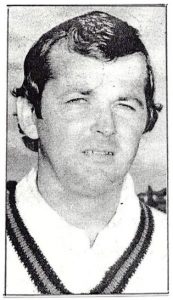
After having played in the lower grades from 1963, Patrick made a rather inauspicious debut in first grade in 1967-68. lt was apparently a “fill-in” match where he did not get a bowl but batted in one innings for 0 runs.
The following season he had a few more games in first grade and took 4 wickets for 60 runs.ln second grade he was beginning to show promise: “Patrick Moylan, our other opening bowler, had a very good season and showed marked improvement gaining more pace and bowling at the off stump. Patrick secured 30 wickets at an average of 15.7.”
By 1969-70 he was holding down a regular place in first grade and took 20 wickets.
However, the following season saw a slump in his form and his wicket tally dropped to 11. His captain, Doug Rawling, commented: “Pat Moylan did not have a good year and it is most difficult to try and analyse just why his bowling did not succeed. His keenness was as strong as ever but somehow his accuracy at times was astray and with so much bowling talent in the team he did not get as much work as I would have liked to give him.”
In 1971-72 Roger opted for a change of club by transferring to Merewether in the Newcastle competition, but he returned the following season to play with Northern in second grade where he took 16 wickets.
That was to be his last season with Northern. He moved on to Raymond Terrace where in a career extending to 1985 he was to achieve some of his best bowling performances, heading the District aggregate in 1974-75 and 1976-77, and playing a large part in that Club’s revival.
Trevor Deamer
Trevor Deamer came to the Club in 1971-72 after having previously played first grade with Combined City during the sixties and with Greta second grade in 1970-71.
In his early career with Combined City, he had been described as “an outstanding pace bowler with a very fluent action”. In 1966 he had suffered a severe setback with a badly broken arm that threatened to end his bowling career.
However, he made a strong resurgence during his time with Northern.
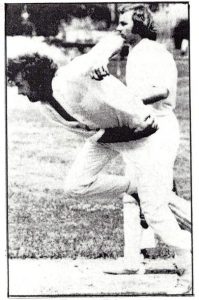
With Keith Smith stepping down to second grade in 1971-72, Trevor took over the opening bowling role in first grade and finished the season with 24wickets. The Club Report commented: “Trevor Deamer in his first season with the Club, could perhaps be described as the unluckiest bowler of the team. Time after time he bowled his heart out, beat the bat and the stumps but did not achieve the results he most assuredly deserved. He kept on trying, bowled extremely fast, and worried most batsmen. His figures certainly did not show his bowling qualities.”
For a couple of seasons, Warren Trappel and Trevor Deamer were to form one of the best opening attacks in the Maitland competition and each one was to provide a perfect foil for the other. In 1973-74 both took 35 wickets and in one match against Wests at Lorn Park they combined to bundle out the opposition for 42 runs with Trevor taking 4-17 and Warren 5-23.
Trevor’s bowling aggregate for each season from 1974-81 was regularly in the range of 20 to 30 wickets. One of his best performances was in the 1976-77 final against Wests when he took 6-37.
In 1979-80 when he took 31 wickets, his captain, Peter Rawling, commented: “Just like Berger Master, Trev just keeps on keeping on. I believe this past season was Trevor’s best ever. A great Club man Trevor always bowled his heart out and two great performances come to mind – 6 for 39 against Police Boys where he gave ‘Big Jack’ (Murray) a closer shave than a Gillette blade and his tremendous performances in the finals,4 for 42 and 3 for 36.”.
At the end of the 1980-81 season after taking 32 wickets, he was beginning to contemplate retirement, claiming that “work commitments and old age” would make him unavailable. However, he appears to have had a change of mind for the following season he ended up captaining the first grade team – a position that he had held back in 1975-76.
After one more season in first grade, he finished his playing career with Northern in 1983-84 in second and third grade.
During his time with the Club Trevor was a very active worker. He was Treasurer from 1974-81; President in his final season; and served at various stages as a Selector and curator. He was involved in organising many of the Club’s social activities and did a lot to foster the after-match “get-togethers” at the Club’s pavilion. For his services to the Club Trevor was made a Life Member.
In paying tribute to Trevor in 1983-84, Phil Warby, the Club Secretary wrote.t.i.as well as being one of the finest opening bowlers, he has also been one of the hardest workers for the Club. As a cricketer, he was one of the most respected bowlers I have played with or against.
Facts and figures don’t always give a true indication of how well a bowler may have bowled during the season and Trevor was a classic example of this. Continually, over the years, Trevor bowled without luck, consistently beating the bat or having chances put down. But this never deterred Trevor from giving his all no matter what the state of the game was, such was his heart.”
David Rawling
David Rawling had an outstanding background as a schoolboy cricketer. As a left-arm opening batsman and medium-pace bowler, he was chosen in 1964-65 in the Under 14 Schoolboys team that represented the State in an interstate Carnival in Brisbane. The following year he captained the NSW Under 14 team in the Carnival at Perth and was subsequently named captain of the honorary Australian Under 14 team.
He started playing third grade with Northern Districts in 1962-63 at a very young age. The team Report noted: “I think mention should be made of 11-year old David Rawling. David started playing at the latter part of the year and only had 8 innings for 50 runs. However, of those 8 innings, 6 were not out giving him an average of 25.0.”
In 1964-65 after scoring 334 in third grade, he was promoted to seconds where he was reported as “showing good style with bat and ball”.ln the third grade final for which he still qualified he took 6 wickets.
The following season he opened the batting in second grade and showed his all-round ability by scoring 355 runs and taking 18 wickets.
After another season in second grade, he began his first grade career in 1967-68. He scored 184 runs and as a first change bowler took 15 wickets. His captain, David Rutherford commented: “David Rawling showed that he will be one of our main batsmen in the seasons ahead even though there were times with his batting when aggression instead of discretion would have been the best course, but I am sure that this will be overcome with the experience he gained in the first grade team last season.”
David regularly played first grade up until 1980 and followed in his father’s footsteps to captain the team from 1972-75. Two of his best seasons were in 1971-72 when he scored 463 runs,
including a century against Raymond Terrace at Lorn; and in 1974-75 when he scored 378, including another century at Lorn against Eastern Suburbs.
Following on from his schoolboy honours, David had a very impressive record in representative cricket. Actually, he was probably the youngest ever to play in a John Bull
Shield match for Maitland. This occurred at a match at Gloucester in 1964 when a Maitland player failed to arrive. David, who was 13 years old at the time and had gone to the match with his father, “filled in” and scored 17 to help Maitland win the game.
After playing for Maitland in the Junior John Bull Shield competition, David went on in 1967-68 to gain a permanent place in the senior team and later captained the side.ln the same season he was also selected to attend the Country Boys Coaching Class.
In 1972-73 he was vice-captain of the Emu Colts team that toured Tasmania and in the following season went on a three months World Tour with the Emu Club.
During the early 1970’s he was a member of, and later captained the senior Hunter Valley representative teams that played in Country Trials against Newcastle. One of his best performances was in 1973-74 when he scored a century to help Hunter Valley defeat the strong Newcastle team. For three seasons from 1973-76, he was chosen in the Combined Hunter Valley/Newcastle teams that played Metropolitan at the Sydney Cricket Ground. He also played for Hunter Valley in four Rothman Knockout matches against Sydney’s first grade teams.
One of the highlights of his representative career came in 1974-75 when he was chosen as twelfth man in the Northern NSW team to play against Mike Denness’ MCC team in Newcastle and was unlucky not to play in the match.
Peter Rawling
Peter Rawling followed a cricket path similar in many respects to that of his older brother. However, unlike David, Peter was a right-hand top-order batsman and an off-spin bowler.
Peter, too, was selected in an NSW Under 14 Schoolboy team – the side that played in Melbourne in 1966-67.
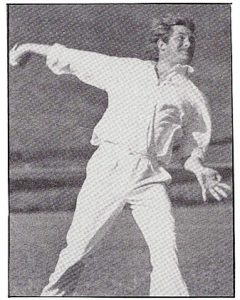
Prior to this, he had played a few matches at a very early age in the Club’s third grade team from 1963-64. Two seasons later he was a regular third grade member and scored an aggregate of 184 runs.
In the team report, he was described as “a particularly handy batsman when the going is hard”.
During the 1966-67 season, he was promoted to second grade after scoring 222 runs in third grade as an opening batsman.
By 1968-69 he started off playing second grade but ended the season playing first grade along with his father and brother. While in second grade he scored a century against Weston Kurri.
The four seasons from 1970-74 when his aggregate was above 300 on three occasions were among somePeter Rawling of his best seasons with the Club. His off-spin bowling also improved markedly during this period with one of his best performances taking place in 1973-74 in a semi-final against Raymond Terrace when he took 5-19 “in a very accurate and sustained bowling effort”. In the same season, he scored a fine 71 in an innings against Easts at East Maitland displaying “great temperament” and a “correct style in both defense and attack”.
The later part of Peter’s career was to be punctuated by a number of Club changes and breaks from cricket.
In a surprise move in the 1974-75 season, he transferred to Police Boys Club and captained their first grade team. Explaining the change, he said that “he wanted to try something on his own” and wanted to “help Police Boys move up in the competition”. The change certainly did not affect his performances as he scored 554 runs and took 23 wickets.
The following season he was back with his old Club. His captain, Trevor Deamer, reported: “P.Rawling.The backbone of our batting all year. His 162 not out at Lorn Park against Police Boys was fantastic. Won both aggregate and average with 366 runs at 45.75. A very good performance. He won these by such a large margin, which shows just how far in front, in terms of run making, he was over the other batsmen. Also bowled well to finish third in the averages with 12 wickets at 12.83”.
After missing the 1976-77 season, he returned in 1977-78 to take 31 wickets, including 7-68 against EMU in the semi-final.
The next season he took out the Association’s Player of the Year Award after a fine all-round performance of 376 runs and 26 wickets.
In 1979-80 he captained the side and although his own performances were disappointing he led the team to a win in the final against Weston Workers.
After failing to complete the 1980-81 season and playing with Raymond Terrace for a season, he again returned to the Club in 1983-84 and had a very successful season scoring 579 runs and taking 15 wickets to win the Player of the Year Award for the second time. The team Report noted: “Peter Rawling who rejoined after a couple of seasons absent proved to be one of our most valuable players. Being named Player of the Year indicates how successful a year Peter had. lt was his experience and ability to knuckle down when the going got tough that helped pull us through several tight matches.”
After another short retirement and a brief return to Norths in 1986-87, he moved to Thornton where he made a “comeback” with that Club and helped them win the first grade major premiership for the first time in 1989-90.
Like his brother, Peter had an outstanding representative record. He was chosen for the Country Boys Coaching Class in 1967-68 and was a regular representative for a number of seasons in Maitland Colts and John Bull Shield teams.
During the seventies he was in a number of senior Hunter Valley teams that played in Country Trial matches against Newcastle and on three occasions was selected in the combined Hunter Valley/Newcastle teams that played against Metropolitan. One of his best efforts was in the Country Trial in 1973-74 when he scored 59 not out and took 5 wickets against Newcastle. He also played for Hunter Valley in four Rothmans Knockout
matches.
His record with the Emu Club was truly exceptional. He was the only player ever to participate in the J.S.White Colts Carnival on six occasions and only the second player ever to be selected in the Emu Colts team for five consecutive tours. Included among these were two tours of NZ and one to Tasmania. After the 1973-74 tour of NZ, he was named Emu Colt of the Year. ln addition, he also went with his brother on the Emu World Tour in 1973-74.
John Rawling
John Rawling was the youngest of the Rawling brothers. He was not short on enthusiasm but he did not have the same cricketing ability as his two older brothers.
During the seventies, he played a mixture of third and second grade matches for the Club and showed his versatility at various stages with his batting, pace bowling, and even wicketkeeping.
His best season was in 1974-75 when he scored 420 runs in third grade including a century. He also played a few matches in the Maitland Under 16 and Colts representative teams.
Les Vickery
Les Vickery was a comparatively late starter as a fast bowler and cricketer. In his early years, he excelled at swimming and did not play any junior cricket.
When he started playing with the Club, he, first of all, bowled spin but was talked into fast bowling by Doug Rawling.
He began his playing career in third grade in 1971-72 when he took 31 wickets. The following season he took 23 wickets in third grade and had a couple of games in second grade, taking a further 11 wickets.
In 1973-74 he had a very successful season in second grade taking 44 wickets at an average of 12.2.
His opportunity to move into first grade came in 1974-75 when Warren Trappel transferred from the Club.
Partnering Trevor Deamer with the new ball, the left-handed Les took 33 wickets in his first season in first grade to head the Club bowling aggregate and win the Roger Moylan Memorial Trophy for the most improved under 21 player in first grade. His captain, David Rawling, commented: ” … with a season under his belt he must improve and with proper guidance with his bowling, could develop into one of the better opening bowlers in the competition.”
The following season was a disappointing one. He bowled only 36 overs compared to 136 the previous season and took just 4 wickets at an average of 45.75. He was reported as “bowling very well at times but without luck”.
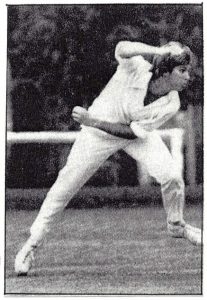
In 1976-77 in a much-improved performance, he took 24 wickets at 11.58 and finished second in the district averages to a fellow team member, Phil Warby. Even his marriage did not interfere with his cricket. The Club Report noted: “Les’ decision to turn up on his wedding day, closely followed by cutting his honeymoon short to attend practice, shows that his heart is in the right place.”
The following season he again headed the Club bowling aggregate with 30 wickets. His captain, Jeff Crittenden, saw his performance as being “outstanding” among the bowlers for the season and “fulfilling the promise shown last season”.
In 1978-79 he was to achieve the highlight of his bowling career. In a first grade match at Robins Oval, he performed the exceptionally rare feat of taking all ten wickets in an innings. The Maitland Mercury gave the following report of his effort “ln a one-man stint of bowling wizardry the 21-year-old first grader took every wicket of GUOOF-City in Saturday’s opening match of the season. The 10 wickets fell for only 14 runs and were claimed in 9.3 overs, three of which were maidens. Six of the wickets were clean bowled and the other four were caught.”
Les’ effort of taking all ten wickets in an innings in first grade had only been achieved once before in the history of the Association – that was back in 1929 when Tom Lindsley, a slow bowler from Branxton, took 10-42 in a match against Kurri at Kurri.
Another remarkable aspect was that Trevor Deamer, who was Les’ opening bowling partner at the other end, was reported as bowling particularly well in his ten-over spell but did not take a wicket.
It was also unusual that after “bagging 10 wickets” in the opening match, Les only took four more wickets for the remainder of the season and with a tally of 14 wickets was not even included in the district averages.
In 1979-80 he transferred to Bolwarra Club where he remained for two seasons before moving on to play with Eastern Suburbs. While with Eastern Suburbs he had his best career season when he headed the District bowling aggregate and averages in 1982-83 with 67 wickets at 11.3.
While playing for Northern Districts, Les represented Maitland in the Colts and John Bull Shield competitions. ln one Colts match against Muswellbrook in the 1973-74 season he took 6-9 in the first innings and followed this up with 3-21 in the second innings. ln 1974-75 with 24 wickets he was the leading wicket-taker for Maitland in the Colts competition.
He also represented Hunter Valley in the Under 23 Colts Carnivals held at Quirindi in 1978-79 and at Maitland in 1979-80.
While with Norths he served on the Management and Social Committees and was Secretary of the Club for two seasons from 1977-79.
Will Callinan
Will Callinan came into first grade in 1973-74 as a sixteen-year-old to take on the role of wicket-keeper after Michael Cox was forced into temporary retirement with a back injury.
He had started playing with the Club in 1970-71 in third grade. The following season he headed the third grade team’s batting aggregate and average with 305 runs at 21.7 and played in the third grade final.
In 1972-73 he was promoted to second grade. His captain, Anthony Enright, gave the following assessment of his wicket-keeping “‘Will Callinan ably replace Dudley Crothers as wicket-keeper and had little difficulty with medium pacers and took some excellent catches. He did, however, have a tendency to snatch at the ball and be almost too quick on some occasions. With some practice against spin bowling and a season or two more in second grade he will be ready for first grade.”
Sooner than anticipated, he was thrust into first grade in 1973- 74.
However, as indicated from the Club Report, he handled the position with distinction: “The team and the Club were very fortunate in having a ‘keeper of the standard of young Will Callinan who more than capably filled the vacant spot in the team. Not only did he keep wickets well, but his batting improved immensely, and in the seasons ahead we can expect Will to be one of our main batting stars. His 37 against Kurri when the team was struggling showed a lot of maturity.” He was also awarded the Roger Moylan Memorial Trophy for the most improved under 21 player in first grade.
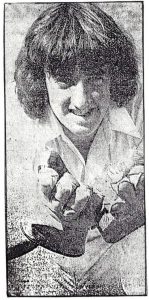
In 1974-75 he scored his first century in first grade – 102 not out against Eastern Suburbs – and finished the season with a very creditable 354 runs.
Although he was not able to match this performance with the bat in subsequent seasons, he still figured in some vital innings, while his wicketkeeping continued to show improvement.
In 1975-76 he was rated by Trevor Deamer, the first grade captain as “one of the best wicket-keepers in the district, making some fine stumpings and taking some fine catches”.
The following season Jeff Crittenden referred to Will in his team report as “our man for a crisis … Starting with his 40 not out in the rain to give us outright victory against Raymond Terrace to his 80 in the semi-finals, Will seemed to be able to pull out that little extra when we were in trouble. His keeping was of a very high quality which can be best judged by the fact that every bowler had confidence in him.”
Will figured in a number of important innings in semis and finals. ln 1979-80 he scored 50 not out against Tenambit-Morpeth in the semi-final and another 50 not out against Weston Workers in the final to play a prominent part in winning the first grade major premiership. His captain Peter Rawling, commented: “Both knocks showed great character and responsibility, getting us out of a lot of trouble and proving to everyone present that Will can do it when he puts his mind to it.”
In 1983-84 when the first grade again won the major premiership, Will figured in a great fightback in the semi-final against Tenambit-Morpeth. After a batting collapse, he shared in a vital ninth wicket partnership of 98 with Rod Langford and scored “a superb 78, a typical performance for him in the semi-finals”.
Will captained the first grade team in 1985-86 but it was a disappointing season with the side finishing second last. The following season he played one of his best innings when he scored 90 against Weston Workers. He continued to play first grade up until 1989 and even ended up opening up the innings.
After a break of a few seasons, he returned in the early 1990’s to play some games in third and fourth grade. Later on, he finished off his career playing a number of seasons in fifth grade and continued to show good form with the bat, helping the fifths win the major premiership in 1994-95 with an aggregate of 479 runs.
On the representative side, Will played for Maitland in the Colts competition, captaining the team in 1977-78. He also represented Hunter Valley in the Under 21 Colts Carnival at Tamworth and in two Under 23 Colts Carnivals at Narrabri.
He was an active member in the Club’s administration serving on the Management and Social Committees, as a Selector, Assistant Secretary, and Secretary for three seasons from 1979-82.
Phil Warby
Phil Warby began playing with the Club in third grade in 1967-68.ln that first season with his left-arm spinners he took five wickets for 60 runs.
The following season he started off in third grade where he “impressed as a real spin prospect” and was then promoted to second grade where he took 11 wickets.
He spent another two seasons in second grade and continued to show a lot of potential, taking 24 wickets in 1969-70 and heading the Club bowling aggregate and average in 1970-71 with 34 wickets at 12.1.
ln one match against Black Hill he took 6-42 in the first innings and 5-18 in the second. In another match on the concrete at Lochinvar, he took 5-26, including a hat-trick, off 10.5 overs.
1971-72 saw him making a successful debut in first grade, taking 32 wickets and scoring 137 runs. In one match against Weston Kurri, he took 6-46 in the first innings and 4-58 in the second.
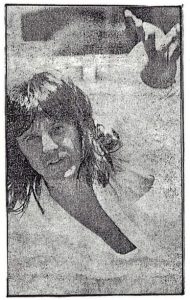
His captain, Doug Rawling, commented: “Philip Warby was given plenty of opportunities to show his potential as a slow left-arm spinner and he came through the season to his credit. He is a real spinner of the ball and will prove invaluable to the team with his ability to capture wickets, wickets which may only be gained through his prodigious spin both ways off the wicket. His batting will prove more advantageous to the team when he learns to control and play his shots and apply himself more adaptly to his cricket.”
During the next three seasons to 1975, Phil did not enjoy the same success with his bowling. He took only 12 wickets in 1972-73, was out for most of the 1973-74 season with a broken leg, and had another lean season in 1974-75 with just 9 wickets.
The 1975-76 season saw him in a new role as opening batsman in first grade, scoring 200 runs from 10 innings. He had very little bowling and took only 4 wickets. The team report noted: “P.Warby, Thrust into the opening role this year and relished it. Likes to keep the scorebook moving, sometimes too quickly and this often brought about his downfall. If. he can control himself and treat every ball on its merits he will have a much better year in ’76/77 with his bowling he only showed glimpses of his true form. On his day he is nearly unplayable.”
1976-77 proved to be one of his best all round seasons. He scored 250 runs and headed the District bowling averages with 24 wickets at 10.7, including a ten wicket haul against Eastern Suburbs when he took 8-30 and 2-31.
In the following season, he had one of his best bowling performances when he took 9-32 off 11 overs against Morpeth-Hinton at Lorn Park.
After playing another season with the Club, he transferred to Raymond Terrace where he remained for three seasons. While with the Terrace, he had a memorable innings in a Prudential Cup match against Weston Workers at Kurri Central when he scored 158 not out, including thirteen sixes and twelve fours.
On his return to Norths in 1982-83, he won the prestigious Player of the Year Award with an outstanding all round performance of 363 runs and 26 wickets. During the season he also scored a century against City United at Robins Oval.
In 1983-84 he captained the first grade team and led it to a double success by winning the minor and major premiership. In 1984-85 he again captained the team and headed the Club’s batting aggregate with 314 runs.
After a further break from the Club from 1986-90, he returned to play a season and a half of first grade and a couple of seasons in second grade before moving to Queensland in 1996. Wayne Goldstein, the second grade captain in 1995-96, gave the following profile of Phil for the season: “This may well have been the old war dog’s last season in Maitland. A smashing all-round season for Warbs with some sparkling performances with both bat and ball and in the field where he really showed the young blokes how to do it.Will be sorely missed next year. Highlight: 58 (including 10 boundaries) v Terrace.”
In his earlier years, Phil had an impressive representative career. He was twice selected for the Country Boys Coaching Class and regularly represented Maitland in the Colts and John Bull Shield competitions over a period of more than 15 years.
In 1972-73 after an impressive performance at the J.S.White Carnival, he was chosen in the Emu Colts team that toured Tasmania.
He represented Hunter Valley in senior Country Trial matches and in 1977-78 was in the Country North-Western team that played in a State Cup competition involving four Country Zones and four Sydney teams.
While with Norths Phil served on the Management and Social Committees for a number of seasons and was Secretary of the Club from 1983-85.
As a bowler, Phil (“Wobbles”) remained something of an enigma. He could bowl an over where he was almost unplayable and could turn a game with a few deliveries. On the other hand, he could be so erratic and loose that a game could be lost in a couple of overs. However, there was one thing that could not be questioned and that was his love of cricket.
Alan Mudd
Alan Mudd, the younger son of Norm Mudd, had a long playing career with the Club that extended for thirty years.
A talented all-rounder, he was one of those players who could be brought into a team to capably fill a specialist position. As a result, he spent quite a few seasons moving up and down from second to first grade.
He started off as a 13-year-old playing in third grade in 1961-62.
Bill Brooker, his captain, summed up his first season: “(Alan) was our substitute wicket-keeper and for his age, did a very good job. Next year, Alan will make his presence felt with bat and ball.”
Bill’s prediction proved to be correct for in the next season Alan showed his all-round potential by hitting up 178 runs and taking 30 wickets in third grade. In 1963-64 he was among the Club’s most improved juniors in third grade, taking 52 wickets, scoring 496 runs, and sharing in three-century partnerships.
The following season he was promoted into second grade as one of the opening bowlers. He was described by team captain, Basil Johnston as “the workhorse of the team bowling 147 overs to take 42 wickets at 12.1 … like his father he has the ability to move the ball late, and if he can build up his physique will be pressing for a place in the firsts within a season or two”.
By 1965-66 when he took 35 wickets in second grade he was described as having the ability “to bowl that really good one that gets his wickets” and making “use of the bumper during the season”.ln the same season he represented Maitland in a second grade representative match against Newcastle.
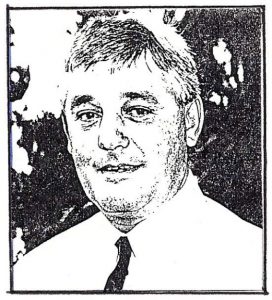
In 1966-67 he was called upon to play his first match in first grade and took 6-63 against Combined City. For the remainder of the season, he played second grade taking 37 wickets, including a hat-trick.
After another season in second grade, he played his first full season in first grade in 1968-69, bowling 103 overs and taking 12 wickets at an average of 28.8.
For the next four seasons, he played mainly second grade with a few games in firsts. An injury in an accident towards the end of the 1971-72 season also affected his performances.
From 1973-77 he came back to play four more seasons in first grade mainly as a specialist batsman. The 1973-74 Report noted: “Alan played several fine innings during the season, at times, when the team really needed runs. His 40 against Easts at Lorn in a partnership with Peter Rawling certainly won the duel with our old rivals and he played really good cricket. Alan’s 63 against Police Boys at Lorn also assisted greatly in the team’s final competition win to take the team to runners-up in the competition.”
His ninth wicket partnership of 104 with David Rutherford against Police Boys at Lorn broke the previous Club record of 91 set by David Rutherford and George Emery back in 1955.
In 1977-78 Alan returned to second grade and resumed his former role as an opening bowler. Mick Hopkins, the captain, reported that Alan “did a fine job as Barry Dixon’s new-ball partner” and that “he readily came back to his old art very well”.He finished the season with 22 wickets and 217 runs.
The following season he had a “ten-wicket haul” in a second grade match against Kurri Workers at Kurri taking 2-23 in the first innings and 8-20 in the second.
During the eighties, Alan continued to gravitate between second and first grade. He captained the second grade for six seasons from 1979-81,1984-85 and from 1987-90 and still continued to turn in some good performances with bat and ball. In 1980-81 he took 44 wickets and in 1985-86 headed the District second grade batting aggregate with 347 runs.
From 1981-83 and in 1986-87 he returned as a regular member of first grade. ln 1981-82 he again opened up the bowling and with 20 wickets at 11.8 was second in the Club’s bowling averages.
At the end of the 1990-91 season after having played for 30 years Alan announced his retirement.
While with the Club Alan had followed in his father’s footsteps and had been very much involved in looking after Lorn Park Oval and the wicket. At various stages, he was curator, assistant curator, and general mechanic. As recorded in the 1988-89 Report tribute was paid to Alan for the “many hours he contributed to the Club by fixing the rollers, filling in as curator or just the general handyman at Lorn Park”.
Alan also served for many years on the Management and Social Committees and in return for his long period of service to the Club both as a player and Club-man was made a Life Member.
Bruce Leary, President of the Club at the time of Alan’s retirement, described him as “one who put his heart and soul into the Club” and commented: “AI has been and always will be Norths – he did it all on and off the field.”
Nic Lutovac
Nick Lutovac was one of the promising youngsters to emerge during the seventies. A hard-hitting batsman, he had the ability to tear an attack apart with one of his powerful onslaughts.
He came into first grade in 1978-79 at the age of fifteen after three seasons in third grade. In his first season in third grade Col Johnston had described him as “a capable batsman” and had given him the following advice to improve his wicket-keeping: “He ‘kept’ most of the season and did well.
He must, however, learn to ‘give’ with his hands when catching, move to the line of the ball rather than falling to it, and to ‘stand-up to the slower bowlers.”
In his last season in third grade, Nick showed marked improvement as a wicket-keeper batsman and scored 253 runs. His captain, Don Nichols, predicted that he would “next season go on to bigger and better things”.
That “next season” saw him promoted to first grade after a couple of good scores in second grade. Jeff Crittenden made a confident prediction that Nick’s “natural ability” would “see him one of the Club’s and District’s leading batsmen for years to come”.
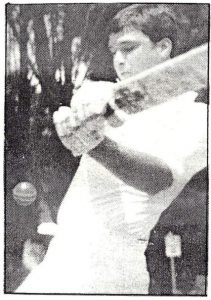
In 1979-80 he began to fulfill the predictions by finishing the season with 391 runs and heading the Club’s batting aggregate and average. The first grade Report noted: “After being dropped to second grade early in the season, Nick came back with a vengeance after Christmas when given a chance at opening the batting. He never looked back, starting with 40 against GUOOF,53 against Tenambit, 69 against East, 58 in the semi against Tenambit, and 60 not out against Kurri in the final. Nick Lutovac has come of age and if he continues his present rate of improvement his future will be assured.”
For each of the next three seasons from 1980-83, Nick scored over 300 runs and headed the Club’s batting aggregate and average on two occasions. Among the highlights of those three seasons was his 76 not out in the 1980-81 semi-final against Bolwarra and his 121 against City at Robins Oval in 1982-83. He also had five stumpings in a match against Raymond Terrace at the Terrace in 1982-83.
For the next three seasons, he played with City United. It was while there that he hit a “blockbuster” double-century against his former Club. In a match at Robins Oval in February 1985 he scored a power-laden 200 that included 20 fours and nine sixes. The innings lasted just over two hours and helped his side to a total of 6-442 – the highest innings total in the history of the Association since 1945. That season Nick topped the District batting aggregate with 448 runs.
After a season with Stockton in the Newcastle competition and a further season with City United, Nick returned to Norths in 1988-89. He captained the first grade team for two seasons taking them to the final in 1988-89 and the semi-finals in 1989-90. He was still very successful with the bat, scoring 350 runs, including a century, in his first season after his return and 424 in the second.
In his representative career, Nick played for Maitland Under 16, Colts, and John Bull Shield teams. He also represented Hunter Valley in Under 14’s, Under 16’s, Colts, and Under 24’s. ln 1982-83 he represented Hunter Valley Under 24’s at the North Western Zone Carnival at Maitland and scored a century against Northern Tablelands. He was subsequently selected in the Combined North Western Zone team that played against the North Coastal Zone team at Armidale and in the Combined North West/North Coast team that played at Maitland. In the same season, he was selected at the J.S.White Carnival in the Emu Colts team to tour Western Australia but withdrew.
Glen Murphy
Glenn Murphy was another young prospect of the seventies who showed a lot of cricket potential.
Like many other Norths’ players, he made his way up through the grades, but more quickly than most. Starting off in third grade in 1976-77, he was promoted to second grade the following season and played his first full season in first grade in 1978-79. His first grade captain, Jeff Crittenden, commented: “Glenn undoubtedly, is one of the best all-round prospects in town and he too will develop further as a bigger workload, with the bat as well as ball, is sure to be given to him next season.”
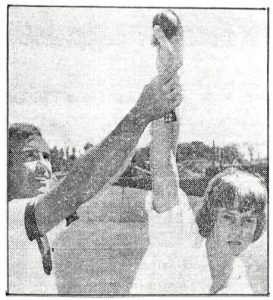
In 1979-80 he had a fine all-round performance scoring 236 runs and taking 29 wickets. Peter Rawling summed up his season’s efforts: “Given the new ball at the start of the season, Murf overcame a patchy start to finish with 29 wickets.
Two great performances come to mind – 5 for 24 against Wests on a hot day and 4 for 36 in the final including the wicket of Neil Fox with the best ball bowled all season. I am not forgetting also his tremendous 66 not out against Tenambit in the first round, this innings proving that Murf will have to bat higher in the future.”
Unfortunately for Norths, Glenn was only to play another season with the Club before moving on. The 1980-81 Report noted with regret: “One bloke who won’t be here next year will be Glenn Murphy and we are really going to miss him. Murph has the ability to go a long way in cricket and I know all Norths’ players will wish him well in Sydney. Both with his bowling and batting last year, Murph always gave a hundred percent.”
In that “last year” Glenn scored 266 runs and took 21 wickets.
In Sydney Glenn played with North Sydney for a number of seasons and as the opening bowler helped them win a first grade minor premiership in 1985-86.
He returned to play a season with his former Club in 1988-89, or as Bruce Leary put it, “Murph had found the train home”. He showed the benefit of his Sydney experience by heading the Club and District bowling aggregate and average with 36 at 12.7. His captain, Nick Lutovac, declared: Glenn Murphy, proved to be the best bowler in the district and the spearhead of the North’s bowling attack. A fine batsman and fielder and the type of player that every captain likes to see in his side.”
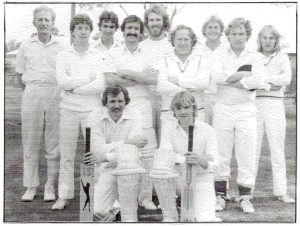
Middle row: A Cant, D Gilmore, B Leary, R Buscombe,
Front: R Cosagrande, S Scobie
Prior to his departure to Sydney, Glenn was chosen for the Country Boys Coaching Class in 1978-79. He also played for Maitland in the Under 16, Colts, and John Shield competitions and represented Hunter Valley in the Under 16’s and Colts.
John Tobin
John Tobin had a short but influential stay with the Club for three seasons from 1976-79.
From the early sixties he had played with Largs Club and then after some time spent teaching in Queensland, he returned to play with Norths in 1976-77.
He came into first grade late in the season and unfortunately broke down before the semi-finals.
For the next two seasons, he captained the second grade team, leading them to be joint finalists in 1977-78 and to be minor premiers in 1978-79.
In 1977-78 John “stole the limelight with the bat “winning the batting aggregate with 437 runs, including a century against Western Suburbs, and seamed the ball very well, especially on wet wickets,” to take 22 wickets.
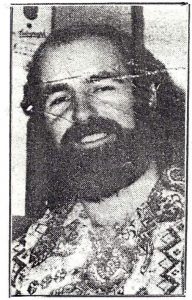
He had another fine all-round season in second grade in 1978-79 heading the District bowling average with 39 wickets at 7.05 and scoring 260 runs. The Club Report spoke of “his knowledge of the finer points in tactics and shrewd judgment in field placement”.It also referred to his bowling performance in one match at Hinton, where he helped to gain an outright victory with nine wickets in the match and had the “added bonus of free medical care offered from the Medic of the Hinton Club”.
John was highly qualified as a cricket coach, being one of the few holders of the Rothmans Advanced Cricket Coaching Certificate. While with Norths he put this expertise to good use as official Club Coach with his work in bringing a more professional approach into the Club’s practice sessions – an area which over the years had been a frequent cause of concern. On the Association level, he was also the Coach and Manager of the Colts team and was the Association’s first Coaching Director.
John served two terms as President from 1977-79 and during that time he helped to arrange further sponsorship of the Club through Booths’ “Sport ‘n’ Things”.
In 1979-80 in a surprise move, he transferred to Bolwarra Club where he remained for a couple of seasons before going on to play with Eastern Suburbs. Later he took up a teaching appointment up the Valley and moved to Muswellbrook.
Eddie French
Eddie French took on the curator’s job in 1970-71 and the following season began playing in third grade, deputising on occasions as captain.
He captained the Club’s third grade team from 1972-74 and in 1977-78, and the fourth grade team from 1978-80. These teams mostly consisted of a sprinkling of senior players with the bulk made up of boys who played in the junior competition on Saturday morning and then turned out for the Club in the afternoon. Eddie often looked after the juniors in the morning and then led them in the afternoon against teams of much older and more experienced players.
Eddie himself had some very good seasons with the bat. ln 1974-75 he topped the District batting aggregate in C grade division 2 with 590 runs, including two centuries. In 1975-76 when third grade won the major premiership under the captaincy of Col Johnston, Eddie scored 311 runs.
His best season was in 1977-78 when he scored 691 runs at an average of 53.15 in third grade division 4. During this season he had the distinction of posting three centuries – all at Marcellin Park. The Club Report noted: “Eddie French was far and away the best and most consistent batsman. His three centuries show that he is a splendid player on concrete. Retiring on a couple of occasions, he was unlucky not to have topped the figures for the grade. He opened throughout the season and invariably gave us a good start so that in the few matches in which he could not play, he was sorely missed. Moreover, his fielding was a model for all and as captain, he had the confidence of the team and the respect of opposing sides. A great club man.”
In 1979-80 he topped the Club’s batting and bowling aggregate in fourth grade with 422 runs and 24 wickets.
Ray Whiteley
Ray Whiteley began playing with the Club in 1976-77 in C grade division 3 in what was described as “a makeshift team to give everyone a game” but which developed into “a well-balanced team that provided many junior lads with a good grounding for grade cricket”. The team was surprised by reaching the semi-finals in which Ray in a beaten side took 8-43 against EMU.
The following season Ray opened the bowling with Keith Smith in third grade division 4. He took 36 wickets but broke his finger just before the semi-finals. In the team Report, Col Johnston wrote of his regular opening bowlers: “He (Keith Smith) remains a magnificent competitor and team man and if I mention Ray Whiteley in the same context, I can give no higher eulogy.”
From 1978-81 he played fourth grade and continued to show improvement, particularly with his batting. In 1979-80 he took out the Club bowling aggregate with 54 wickets, and the following season he headed the Club bowling aggregate with 62 wickets and the batting aggregate and average with 410 runs at 24.1.
In 1981-82 he took on the captaincy of the C grade team and continued in that position up until 1987. At times the team was a rather motley group with a mix of Rugby Union and hockey players, youngsters and veterans thrown together and identities such as “Boris”, “Keg”, “Bonehead”, “Chair” and “Patsy”.While Ray was the official captain, there appear to have been times when a rotation system of “captain for a day” operated. However, Ray managed to mold his teams into an enthusiastic and competitive group who enjoyed their cricket and the socialising afterward.
As captain, Ray continued to put in some good performances in bowling and batting. ln each of the three seasons from 1981-84 he took over 40 wickets and in 1982-83 scored a century against Weston Workers. He also played a leading role in the Club’s C grade major premiership win in 1982-83, taking 7-28 in the semi-final against SMR and 9-27 in the final against Thornton.
In 1986-87 Ray started off as captain of C grade and when that team folded moved up into third grade. There his captain, Glen Kirkwood, noted: “R.Whiteley. What can I say? He can still bat and is getting plenty of wickets. Full of moral support.” After a brief retirement, he played his last season with the Club in C 3 grade in 1989-90.



